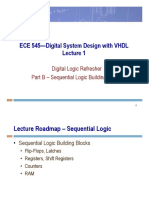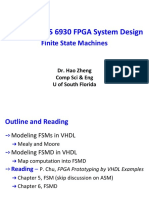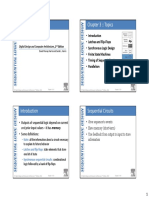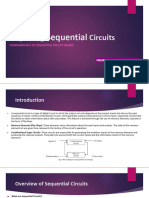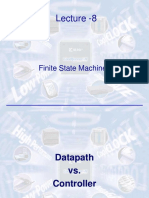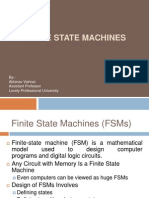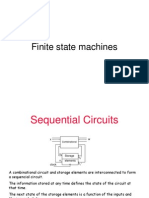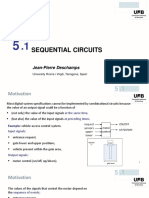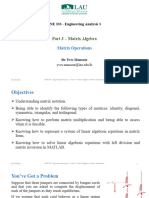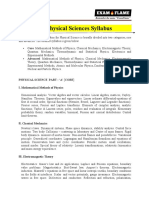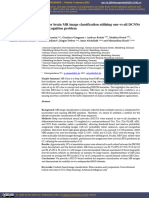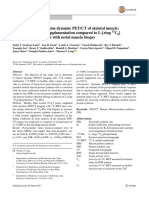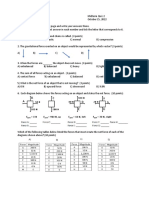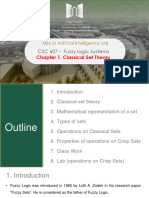ECE 545Digital System Design with VHDL Lecture 3
Sequential Logic Review and Algorithmic State Machines 9/9/08
Outline
Sequential Logic Building Blocks
Latches, Flip-Flops
Sequential Logic Circuits
Registers, Shift Registers, Counters Memory (RAM, ROM) Simple Finite State Machines (Mealy, Moore)
Complex Digital System Design with ASMs
Examples
�Textbook References
Sequential Logic Review
Stephen Brown and Zvonko Vranesic, Fundamentals of Digital Logic with VHDL Design, 2nd or 3rd Edition
Chapters 7 and 8
OR your undergraduate digital logic textbook (chapters on sequential logic and state machines)
Algorithmic State Machines
Stephen Brown and Zvonko Vranesic, Fundamentals of Digital Logic with VHDL Design, 2nd or 3rd Edition
Chapter 8.10 Algorithmic State Machine (ASM) Charts Chapter 10.2.1 A Bit-Counting Circuit Chapter 10.2.2 ASM Chart Implied Timing Information Chapter 10.2.6 Sort Operation (handouts distributed in class)
3
Sequential Logic Building Blocks
some slides modified from: Brown and Vranesic, Fundamentals of Digital Logic with VHDL Design, 2nd Edition S. Dandamudi, Fundamentals of Computer Organization and Design
�Introduction to Sequential Logic
Output depends on current as well as past inputs
Depends on the history Have memory property
Sequential circuit consists of
Combinational circuit Feedback circuit
Past input is encoded into a set of state variables
Uses feedback (to feed the state variables)
Simple feedback Uses flip flops
Introduction (contd)
Main components of a typical synchronous sequential circuit (synchronous = uses a clock to keep circuits in lock step)
INPUT COMBINATIONAL LOGIC PRESENT STATE S(t) STATE-HOLDING ELEMENTS (i.e. FLIP-FLOPS)
OUTPUT
NEXT STATE S(t+1)
CLOCK
6
�State-Holding Memory Elements
Latch versus Flip Flop
Latches are level-sensitive: whenever clock is high, latch is transparent Flip-flops are edge-sensitive: data passes through (i.e. data is sampled) only on a rising (or falling) edge of the clock Latches cheaper to implement than flip-flops Flip-flops are easier to design with than latches
In this course, primarily use D flip-flops
D Latch vs. D Flip-Flop
D Q CLK
D CLK Q
Latch transparent when clock is high
D
D Q CLK
CLK Q
Samples D on rising edge of clock
8
�D Flip-Flop (positive edge triggered)
1
D
P3
1
2
P1 5
0
Q
Clock
0 1
3 P2 6
D
4 D P4 Clock Q
D
(a) Circuit (b) Graphical symbol
NAND : one input 0, output always 1; all inputs 1 except A, output is A
9
D Flip-Flop (positive edge triggered)
D
1 P3
1
2
P1
D 0
5
D
Q
Clock
1 1
3
DP2
D
D Q
D
4 D P4 Clock Q
D
(a) Circuit (b) Graphical symbol
NAND : one input 0, output always 1; all inputs 1 except A, output is A
10
�D Flip-Flop with Asynchronous Preset and Clear
Preset
Bubble on the symbol means active-low
Q
Clock Q
When preset = 0, preset Q to 1 When preset = 1, do nothing When clear = 0, clear Q to 0 When clear = 1, do nothing
D Clear
(a) Circuit
Preset D Q Q Clear
Preset and Clear also known as Set and Reset respectively In this circuit, preset and clear are asynchronous
Q changes immediately when preset or clear are active, regardless of clock
11
(b) Graphical symbol
D Flip-Flop with Synchronous Clear
D
Clear D Clock D Q Q Q Q
CLK CLEAR
Q
(asynchronous clear)
Q
(synchronous clear)
Asynchronous active-low clear: Q immediately clears to 0 Synchronous active-low clear: Q clears to 0 on rising-edge of clock
12
�Other Types of Flip-Flops
D Flip-Flop
D Q CLK D 0 1 Q(t+1) 0 1
Set-Reset (SR) Flip-Flop
S Q CLK R S 0 0 1 1 R 0 1 0 1 Q(t+1) Q(t) 0 1 not allowed
Toggle (T) Flip-Flop
T Q CLK T 0 1 Q(t+1) Q(t) Q(t)
JK Flip-Flop
J Q CLK K J 0 0 1 1 K 0 1 0 1 Q(t+1) Q(t) 0 1 Q(t)
13
Sequential Logic Circuits
some slides modified from: Brown and Vranesic, Fundamentals of Digital Logic with VHDL Design, 2nd Edition S. Dandamudi, Fundamentals of Computer Organization and Design
14
�Register
D(3)
D Q CLK
Q(3)
D(2)
D Q CLK
Q(2)
D(1) D(0)
D Q CLK D Q CLK
Q(1) Q(0)
In typical nomenclature, a register is a name for a collection of flip-flops used to hold a bus (i.e. std_logic_vector)
15
Shift Register
In Clock D Q Q Q1 D Q Q Q2 D Q Q Q3 D Q Q Q4 Out
(a) Circuit
In 1 0 1 1 1 0 0 0 Q1 0 1 0 1 1 1 0 0 Q2 0 0 1 0 1 1 1 0 Q3 0 0 0 1 0 1 1 1 Q4 = Out 0 0 0 0 1 0 1 1
t0 t1 t2 t3 t4 t5 t6 t7
(b) A sample sequence
16
�Parallel Access Shift Register
Parallel output Q3 Q2 Q1 Q0
Q Q
Q Q
Q Q
Q Q
clock serial_in parallel_in 4 shift/load SHIFT REGISTER 4 output
Serial input
Shift/Load
Parallel input
Clock
17
Synchronous Up Counter
Enable D0
0 1
Q Q
Q0
enable
0
D1
Q Q
Q1
load D0 D1 D2
carry Q0 Q1 Q2 Q3
D2
Q Q
Q2
D3
clock
0
D3
Q Q
Q3
Output carry Load Clock
Enable (synchronous): when high enables the counter, when low counter holds its value Load (synchronous) : when load = 1, load the desired value into the counter Output carry: indicates when the counter rolls over D3 downto D0, Q3 downto Q0 is how to interpret MSB to LSB
18
�Memories
some slides modified from: Brown and Vranesic, Fundamentals of Digital Logic with VHDL Design, 2nd Edition S. Dandamudi, Fundamentals of Computer Organization and Design
19
Random Access Memory (RAM)
More efficient than registers for storing large amounts of data Can read and write to RAM Addressable memory Can be synchronous (with clock) or asynchronous (no clock) SRAM dimensions are:
(number of words) x (bits per word) SRAM 2m x n-bit RAM
data in (n)
data out (n)
address (m) RAM write read
Address is m bits, data is n bits
Example: address is 5 bits, data is 8 bits
32 x 8-bit RAM Data_in and address are stable Assert write signal (then de-assert) Address is stable Assert read signal Data_out is valid
Write Read
20
�Random Access Memory (RAM)
Data inputs Write dn 1 d n 2 d0
Sel0 Sel1 m-to-2m decoder a0 a1 Address am 1 Sel2
Sel2m 1
Read Data outputs qn 1 qn 2 q0
21
Read Only Memory (ROM)
Similar to RAM except read only Addressable memory Can be synchronous (with clock) or asynchronous (no clock)
data in (n)
data out (n)
address (m) ROM
read
22
�Read-Only Memory (ROM)
Sel0 Sel1 m-to-2m decoder a0 a1 Address am 1 Sel2 0/1 0/1 0/1 0/1 0/1 0/1 0/1 0/1 0/1
Sel2m 1
0/1
0/1
0/1
Read Data dn 1 dn 2 d0
23
Simple Finite State Machines
24
�Finite State Machines (FSMs)
Any Circuit with Memory Is a Finite State Machine
Even computers can be viewed as huge FSMs
Design of FSMs Involves
Defining states Defining transitions between states Optimization / minimization
Above Approach Is Practical for Simple FSMs Only
25
Mealy vs. Moore State Machines
Finite State Machines (FSM) are of two types: Moore Machines
Next State = Function(Input, Present State) Output = Function(Present State)
Mealy Machines
Next State = Function(Input, Present State) Output = Function(Input, Present State)
26
�Moore FSM
Output Is a Function of a Present State Only
Inputs Next State Function
(comb. logic)
Next State clock reset Present State Register
Present State
Output Function
(comb. logic)
Outputs
27
Mealy FSM
Output Is a Function of a Present State and Inputs
Inputs Next State Function
(comb. logic)
Next State clock reset Present State Register
Present State
Output Function
(comb. logic)
Outputs
28
�Moore Machine
transition condition 1 state 1 / output 1 state 2 / output 2 transition condition 2
29
Mealy Machine
transition condition 1 / output 1 state 2 transition condition 2 / output 2
state 1
30
�Moore vs. Mealy FSM (1)
Moore and Mealy FSMs can be functionally equivalent
Equivalent Mealy FSM can be derived from Moore FSM and vice versa
Mealy FSM Has Richer Description and Usually Requires Smaller Number of States
Smaller circuit area
31
Moore vs. Mealy FSM (2)
Mealy FSM computes outputs as soon as inputs change
Mealy FSM responds one clock cycle sooner than equivalent Moore FSM
Moore FSM Has no combinational path between inputs and outputs
Moore FSM is more likely to have a shorter critical path Moore outputs synchronized with clock; Mealy outputs may not be (may have race conditions, timing issues, etc.)
32
�Moore FSM - Example 1
Moore FSM that Recognizes Sequence 10
0 S0 / 0 reset Meaning of states: S0: No elements of the sequence observed 1 1 S1 / 0 0 1 S2 / 1
0 S1: 1 observed S2: 10 observed
33
Mealy FSM - Example 1
Mealy FSM that Recognizes Sequence 10
0/0 S0 reset Meaning of states: S0: No elements of the sequence observed 0/1 S1: 1 observed 1/0 S1 1/0
34
�Moore & Mealy FSMs Example 1
clock 0 input S0 Moore S0 Mealy S1 S0 S0 S0 S1 S2 S0 S0 1 0 0 0
35
FSM Limitations
Simple finite state machines (those expressed using state diagrams and state tables) good only for simple designs
Many inputs and many outputs make it awkward to draw state machines Often only one input affects the next change of state Most outputs remain the same from state to state
Instead use algorithmic state machines (ASM)
36
�Complex Digital System Design with Algorithmic State Machines
37
Complex Digital System Design
external inputs control signals CONTROLLER status signals DATAPATH data input
external outputs
Some refer to this as the register-transfer level (RTL) design method
data output
Complex digital systems can be decomposed into a datapath and controller Datapath manipulates and processes data
To perform arithmetic, logic, shifting, and other data-processing tasks These operations are implemented with ALUs, registers, multiplexers, adders, comparators, etc. Controller provides signal to activate various processing in the datapath
Example: enable signals for registers Example: control signals for muxes
Controller determines the enabling and sequencing of datapath operations
Controller also determines the sequence the operations are performed
38
�Inputs and Outputs
external inputs control signals CONTROLLER status signals DATAPATH data input
external outputs
Datapath inputs and outputs
External data input
Example: data to be processed Example: result data Example: when an adder has overflowed
data output
External data output Status signals to the controller (to indicate what is occuring in the datapath)
Controller inputs and outputs
External inputs
Example: reset signal, mode select Example: done flag to outside world Example: mux select, enable signals
External outputs Control signals to the datapath
39
Controller
Controller can be programmable or non-programmable Programmable
Has a program counter which point to next instruction Instructions are held in a RAM or ROM externally Microprocessor is an example of programmable controller
Non-Programmable
Once designed, implements the same functionality Another term is a hardwired state machine or hardwired instructions We will be focusing primarily on the non-programmable type in this course
40
�Algorithmic State Machine (ASM)
Complex digital systems can be represented by algorithmic state machines Simple finite state machines (expressed using state diagrams and state tables) good only for simple designs Algorithmic State Machines (ASM) are
flow-chart type diagrams to represent finite state machines suitable for a larger number of inputs and outputs compared to simple FSMs
41
Elements used in ASM charts
State name Output signals or actions (Moore type)
0 (False)
Condition expression
1 (True)
(a) State box
(b) Decision box
Conditional outputs or actions (Mealy type)
(c) Conditional output box
42
�State Box
State box represents a state. Equivalent to a node in a state diagram or a row in a state table. Contains register transfer actions or output signals Moore-type outputs are listed inside of the box. It is customary to write only the name of the signal that has to be asserted in the given state, e.g., z instead of z=1. Also, it might be useful to write an action to be taken, e.g., count = count + 1, and only later translate it to asserting a control signal that causes a given action to take place.
State name Output signals or actions (Moore type)
43
Decision Box
Decision box indicates that a given condition is to be tested and the exit path is to be chosen accordingly The condition expression consists of one or more inputs to the FSM.
0 (False)
Condition expression
1 (True)
44
�Conditional Output Box
Conditional output box Denotes output signals that are of the Mealy type. The condition that determines whether such outputs are generated is specified in the decision box.
Conditional outputs or actions (Mealy type)
45
ASMs representing simple FSMs
Algorithmic state machines can model both Mealy and Moore simple finite state machines Three examples follow
46
�Moore FSM Example 1: State diagram
Reset w = 1 w = 0 Az=0 w = 0 w = 0 w = 1 Bz= 0
Cz = 1
w = 1
47
ASM Chart for Moore FSM Example 1
Reset A
w 1 B
w 1
C z
48
�Mealy FSM Example 2: State diagram
Reset w = 1z= 0 w = 0z= 0 A w = 0z= 0 B w = 1z= 1
49
ASM Chart for Mealy FSM Example 2
Reset
w 1
B z
50
�Control Unit Example: Arbiter (1)
reset
r1 r2 r3
g1
Arbiter
g2 g3
clock
51
Control Unit Example: Arbiter (2)
Reset Idle 0xx 1xx 000
gnt1 g1 = 1 1xx gnt2 g2 = 1 x1x gnt3 g3 = 1 xx1
52
x0x
01x
xx0
001
�Control Unit Example: Arbiter (3)
Reset Idle r1 r1 r 1r 2 r 3
gnt1 g1 = 1 r2 r1 gnt2 g2 = 1 r3 r2 gnt3 g3 = 1 r3
53
r 1r 2
r 1r 2 r 3
ASM Chart for Control Unit - Example 3
Reset
Idle
r1 0
1 gnt1 g1 1 gnt2 g2 1 r2 0 1 r1 0
r2 0
0 r3
1 gnt3 g3 1 r3 0
54
�Complex Digital System Design: ASM Design Steps
55
Complex Digital Design: ASM Design Steps
Given a specification, to design a complex digital system using ASMs, the following steps are involved:
1. 2. 3. 4. 5. Translate specification into pseudocode. Translate pseudocode into a high-level ASM. Also called pseudocode ASM, since it uses pseudocode instead of actual signal names. Design a datapath block diagram based on high-level ASM. Also called an execution unit. (Some references decompose block diagram into a datapath block diagram and controller block diagram.) Draw top-level interface diagram. This diagram connects the datapath with the controller to show all inputs, outputs, and internal connections of the entire digital system. Design detailed controller ASM based on high-level ASM. Detailed means using the exact signal names, not pseudocode representations. Datapath: represented by a datapath block diagram Controller: represented by a detailed controller ASM Top-Level: represented by top-level interface diagram
After this process you have three results:
From this it is easy to translate into VHDL
56
�Examples
We will do examples in class:
Bit-counting circuit Sorting circuit
57















